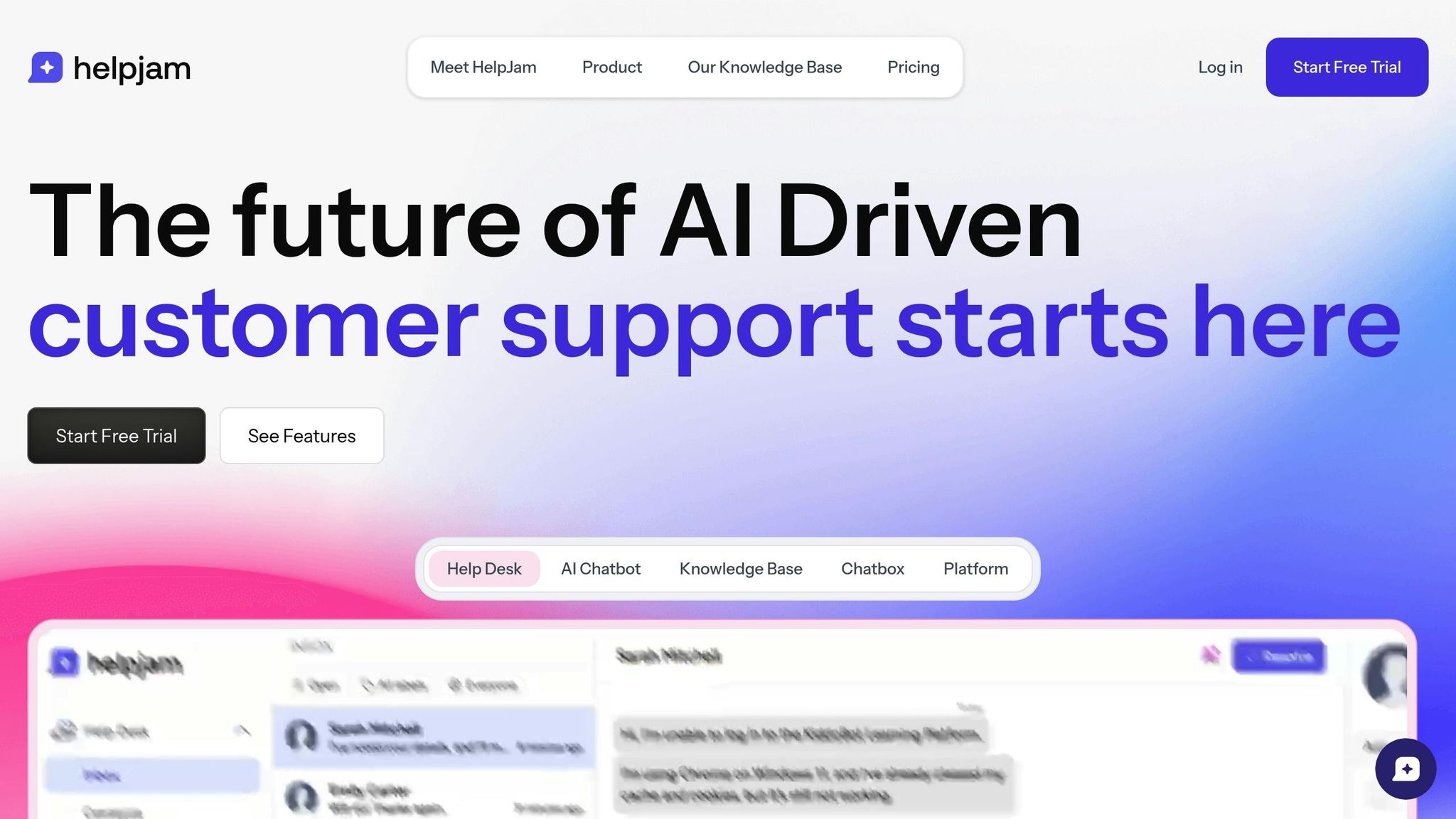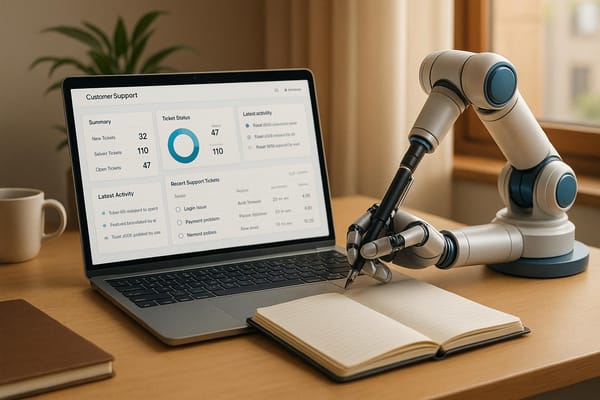5 Key Metrics for Customer Support Success
Track essential customer support metrics like FCR and CSAT to enhance satisfaction and efficiency while reducing costs.

In customer support, tracking the right metrics can boost satisfaction, reduce costs, and improve efficiency. Here are the 5 key metrics every business should monitor:
- First Contact Resolution (FCR): Measures how often issues are resolved in the first interaction. Higher FCR leads to happier customers and lower costs. Aim for 80%+.
- Knowledge Base Self-Service Rate: Tracks how many customers solve issues using self-service resources. Clear, accessible content can save millions annually.
- AI Chatbot Resolution Rate: Measures how effectively chatbots handle queries without human involvement. Target 80-85% for cost savings and efficiency.
- Support Response Time by Language: Tracks response times across languages to ensure fast, accurate global support. Use AI tools to reduce delays by 70%.
- Customer Satisfaction (CSAT): Evaluates satisfaction across languages, considering cultural differences and regional expectations.
Quick Tip: Tools like HelpJam can simplify tracking and improving these metrics with AI-driven insights and multilingual support capabilities.
1. First Contact Resolution Rate
First Contact Resolution (FCR) measures how often customer issues are resolved during the very first interaction. It's a key indicator of how efficient your support team is. A higher FCR rate means your team can address problems promptly, which leads to happier customers and lower support costs.
Why First Contact Resolution Matters for Support Quality
Studies reveal that FCR is closely tied to customer loyalty and satisfaction. When customers get their issues resolved on the first try, they’re 5-10% more likely to stick with your business. Leading support teams often achieve FCR rates of 80% or more, compared to the industry average of 70-75%.
For example, T-Mobile improved its FCR rate from 71% to 86% by leveraging AI tools, which also led to a 12% jump in customer satisfaction (CSAT). Here’s why FCR is so impactful:
- Higher CSAT: A 1% increase in FCR can boost CSAT by 1-5%.
- Cost Savings: Reducing repeat contacts by 25-30% lowers operational costs.
- Stronger Customer Retention: Loyalty rates can improve by 5-10%.
This metric becomes even more important in multilingual support scenarios, where language differences can make resolving issues more challenging.
How HelpJam Helps Improve First Contact Resolution

HelpJam offers tools designed to enhance FCR rates. Its AI-powered inbox organizes and prioritizes tickets, while smart routing ensures that complex queries go directly to the right agents without delay.
Some standout features include:
- AI-Powered Solution Suggestions: HelpJam integrates knowledge base content into live conversations, providing relevant solutions in real-time.
- Intelligent Ticket Routing: Tickets are assigned based on an agent's expertise and past performance. The system also routes tickets to agents fluent in the customer’s language, ensuring smoother interactions.
These features make it easier for teams to resolve issues quickly and efficiently, even in complex or multilingual environments.
2. Knowledge Base Self-Service Rate
While First Contact Resolution (FCR) focuses on live interactions, the self-service rate measures how effectively customers resolve issues on their own. This metric plays a big role in cutting support costs and improving customer satisfaction, especially in multilingual environments.
Measuring Self-Service Success
The self-service rate tracks the percentage of customers who successfully find answers in your knowledge base without needing to contact support. For example, Shopify boosted its self-service rate by 15 percentage points using AI-driven content tools, saving $1.8 million annually.
Several factors impact self-service success, including:
- Content quality and relevance: Are the articles clear and helpful?
- Search effectiveness: Can users easily find what they need?
- Mobile accessibility: Is the knowledge base user-friendly on mobile devices?
HelpJam's Knowledge Base Tools
HelpJam takes self-service to the next level by building on its language-aware ticket routing system. Its knowledge base can automatically create and update content in over 12 languages, which has been shown to improve self-service rates by up to 40% in non-English-speaking markets. Customers are far more likely to use resources written in their native language.
Key features of HelpJam's platform include:
- AI Content Generation: Quickly produce high-quality articles.
- Smart Search: Uses natural language processing for better search results.
- Analytics Dashboard: Tracks user behavior to identify gaps.
- Multilingual Support: Automates translations to expand accessibility.
HelpJam's AI-powered analytics ensure continuous improvement by:
- Running regular content audits to maintain accuracy.
- Monitoring search patterns to identify missing content.
- Updating multilingual resources to keep pace with customer needs.
With this data-driven approach, HelpJam ensures your knowledge base stays effective, helping customers solve problems independently. And when self-service doesn't work, AI chatbots step in - making their resolution rate the next metric to watch.
3. AI Chatbot Resolution Rate
When self-service options fall short, AI chatbots step in as the next line of support. This makes their resolution rate a crucial metric to monitor. It measures how many inquiries the chatbot resolves without human involvement, directly influencing efficiency and reducing costs - especially in multilingual settings.
Understanding AI Support Performance
A higher resolution rate signals that the AI is handling queries effectively, which can lead to significant cost savings. According to industry data, the best-performing AI chatbots resolve 80-85% of inquiries, while the average sits at 69%. In top cases, service costs are cut by 30%.
Several factors influence resolution rates:
- Query Complexity: Straightforward, repetitive questions are easier for AI to resolve.
- Language Processing Capability: The ability to accurately interpret customer intent plays a big role.
HelpJam's AI Chatbot Capabilities
HelpJam's AI chatbot platform excels with advanced natural language processing and robust multilingual support. By keeping track of conversation context, it delivers more precise answers.
Features that boost its resolution performance include:
- Smart Escalation: Automatically routes more complex issues to human agents.
- Sentiment Analysis: Identifies customer frustration and adjusts responses accordingly.
- Performance Analytics: Monitors resolution rates and pinpoints areas for improvement.
- Custom Training: Quickly updates AI models to address specific support needs.
HelpJam's chatbot leverages machine learning to study successful resolutions across different languages, constantly refining its responses. This metric becomes even more insightful when paired with language-specific response time tracking, which we’ll dive into next.
4. Support Response Time by Language
Keeping track of how quickly you respond in different languages is key to keeping customers happy in global markets. With 42% of consumers valuing support in their native language over price, businesses need to ensure quick replies no matter the language. This metric builds on HelpJam's language-aware tools, ensuring speed goes hand-in-hand with accuracy. It also directly influences customer satisfaction scores across all languages - something we'll dive into next.
Response Time and Customer Satisfaction
Here’s what customers typically expect:
- Emails: Responses within 24 hours
- Live chats: Replies in under 2 minutes
- Social media: Interaction within 60 minutes
For multilingual support teams, meeting these expectations can be tricky due to:
- Limited access to language experts
- Complex technical queries that need accurate translations
AI translation tools are a game-changer, cutting delays by 70% for non-native queries. This shows how technology can help close language gaps effectively.
HelpJam's Multilingual Support Tools
HelpJam simplifies managing responses in multiple languages with features like:
- Automatic Language Detection: Instantly directs queries to the right team.
- Real-Time Translation: Provides AI-generated replies in over 50 languages.
- Language-Specific Analytics: Monitors performance metrics for each language.
- Localized Response Templates: Pre-approved messages tailored to regional norms.
The platform’s analytics dashboard helps teams set goals based on:
- Query volume trends by language
- Agent availability across time zones
- Ratio of technical versus basic inquiries
- Regional service expectations
These tools make it easier to deliver fast and accurate support, no matter the language or location.
5. Customer Satisfaction Across Languages
Customer satisfaction (CSAT) scores can highlight gaps in the quality of multilingual support. This metric adds another layer to understanding support performance, alongside response time and resolution rates, especially in global markets.
Measuring Support Quality by Language
To measure satisfaction effectively, you need to factor in cultural differences and regional expectations. Here's what matters most:
Cultural Response Patterns
People from different cultures approach feedback differently. In some regions, customers may lean toward moderate ratings, while others might give more extreme scores. These cultural tendencies should be considered when comparing CSAT data across markets.
Language-Specific Benchmarks
Set satisfaction targets tailored to each language. These benchmarks should align with regional expectations and service-level agreements, ensuring evaluations are fair and culturally appropriate.
HelpJam's Customer Satisfaction Tools
HelpJam offers tools designed to improve multilingual satisfaction tracking:
Real-Time Satisfaction Monitoring
- Tracks customer sentiment across languages, linking it to resolution rates and response times.
- Offers customizable surveys with questions tailored to cultural nuances.
- Provides insights into language-specific trends.
Language-Specific Analytics
The dashboard lets you filter satisfaction data by:
- Language of interaction
- Preferred communication channels
- Speed of resolution
- Use of self-service options
AI-Enhanced Support Quality
HelpJam ensures consistent service across languages by:
- Using automated responses that are culturally aware.
- Monitoring satisfaction levels proactively.
- Continuously analyzing feedback to refine support.
When combined with resolution rates and response times, these tools give you a well-rounded strategy for delivering excellent global support. CSAT becomes the final piece of the puzzle, tying operational metrics to customer experience.
Conclusion: Using Metrics to Improve Support
The five metrics discussed work together as a system - improving one often has a positive effect on the others. HelpJam’s analytics platform seamlessly connects these metrics, making it easier to track and enhance support performance.
Support Metrics Best Practices
Boost your support team's performance by following these key practices:
- Set clear baselines through consistent tracking to measure progress.
- Link metrics to specific actions that directly address areas for improvement.
- Balance automation with human expertise to maintain both efficiency and a personal touch.
Turning Metrics into Action
Every metric should lead to actionable steps for improvement:
- First Contact Resolution Rate: Pinpoint common reasons for escalations.
- Knowledge Base Self-Service Rate: Identify missing or unclear content.
- AI Chatbot Resolution Rate: Fine-tune automated responses for better outcomes.
- Support Response Time: Adjust team schedules to reduce delays.
- Customer Satisfaction: Tackle language-specific issues or recurring complaints.
Blend Automation with Human Interaction
Automation can streamline processes, but it’s crucial to retain the human aspect in customer support for a well-rounded experience.
HelpJam's Support Analytics Platform
HelpJam’s platform uses AI to turn raw metrics into actionable insights, all within a single, easy-to-use dashboard.
Real-Time Performance Tracking
- Access real-time dashboards that monitor language-specific trends with AI-powered detection.
- Generate automated reports for quick updates on performance.
Actionable Insights
- Track customer satisfaction trends over time.
- Receive AI-driven recommendations for improving support strategies.
- Analyze performance across all customer interaction channels.
FAQs
What are the 5 key performance indicators for customer service?
The five main KPIs for evaluating customer service success are:
- First Contact Resolution Rate: Aim for over 80%.
- Knowledge Base Self-Service Rate: Look for a 40%+ increase in non-English markets.
- AI Chatbot Resolution Rate: Target 80-85% efficiency.
- Support Response Time by Language: Keep live chat response times under 2 minutes.
- Customer Satisfaction Across Languages: Use benchmarks tailored to each language.
HelpJam's analytics dashboard monitors these metrics in real-time across all support channels. Its multilingual AI tools improve automation and translation in over 50 languages, ensuring consistent support quality worldwide.
What are KPI metrics for customer service?
Customer service KPIs assess how well support teams handle issues, enable self-service, and maintain satisfaction across languages. HelpJam tracks these metrics to help teams refine their global support efforts.
Key metrics include:
- Resolution speed
- Support accuracy
- Knowledge base usage
- AI chatbot efficiency
- Self-service adoption
- Support costs
HelpJam's integrated analytics dashboard provides detailed tracking of these KPIs, enabling teams to pinpoint areas for improvement and enhance performance across all channels.
Start your free trial with HelpJam today to elevate your customer support!





